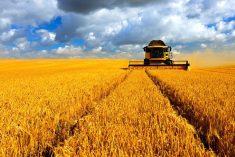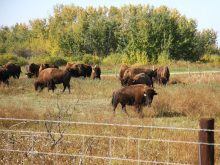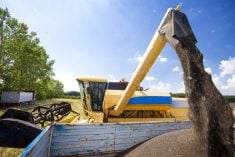RADISSON, Sask. — Dave Buckingham, mayor of Borden, Sask., says the railway tracks that run alongside his west- central, Saskatchewan community are saving his town from significant damage.
Melt water has built up along the south side of the community, and around a grain elevator that Luke Walker and his family own.
The family is fighting the flood waters to protect their farm’s elevator. The Walkers are building dikes and pumping to protect their elevator’s mechanical equipment, pit and drag, as well as bin bottoms. The elevator is largely empty of grain.
Read Also

China’s canola, soybeans imports to drop one million tonnes each
China is expected to import one million tonnes less of canola in 2025/26 than in the previous marketing year, the United States Department of Agriculture attaché in Beijing projected. China was projected to acquire 3.10 million tonnes of canola this year versus 4.10 million in 2024/25.
“But we’re trying to protect the elevator’s systems. Most of that is below grade or at the bottom of the elevator, where it could get pretty wet,” he said.
Across the rail bed and Highway 16, the Yellowhead as it is known to Prairie folks, the Alaska Highway to the rest of North America, the small town of Borden pushes back against the late and concentrated melt of a record snowfall.
Buckingham said the community is experiencing unprecedented flooding.
Water is coming from across the watershed west of Borden headed for the ice filled North Saskatchewan River.
There is a significant amount of melting yet to occur and warm weather on its way to deliver that flow, he says.
The town has been working around the clock for several days to set up sandbag walls and as of this morning the temporary dikes were holding.
“We’ve got seven, six inch pumps in the past day and that is helping, too. But we are an island and on the other side of the highway and the CN (rail bed) a 10 foot wall of water is backed up, draining through town,” said the mayor.
“We’ve had hundreds of volunteers, working around the clock. Half a dozen homes have been damaged and we’ve had to evacuate a some acreages, but we are holding it back so far.”
He said the town and municipality have been working with provincial water security agency and highways as well as Canadian National Railway to monitor the flow.
“Road loss within the municipality has been significant, up to Radisson and beyond,” said the mayor.
A dozen kilometers north up the highway, the town of Radisson gets a portion of the Borden flood water first.
There, water is running through one corner of the community, winding its way between houses, down alleys and past a seniors’ home, slicing the town in two.
Monday night Mayor Don Tanner could be seen running a backhoe in that town as a few staff and an army of volunteers cut the roads and diverted the flows, moving water out of town and onto farmland and marshy ground toward the river and Borden.
“None of our small towns could manage these disasters without volunteers and we’ve had lots. Likely will be needing more,” he said.
Murray King lives along a small ditch in Radisson.
“We’ve never seen water like this. We’ve been in this house 27 years. Nothing like this,” he said, as a Saskatoon water contractor set up a pair of six inch pumps in front of his house to assist an over-taxed culvert and keep the only road to the southern part of the town open.
While a grid road would normally allow residents of that area an exit to from town to the southwest, it has been cut to accommodate the melt water as it rushes to the river.
Rural municipal officials said many of the region’s roads have been cut to avoid washouts or extreme flooding situations.
Both towns have declared disasters.
















